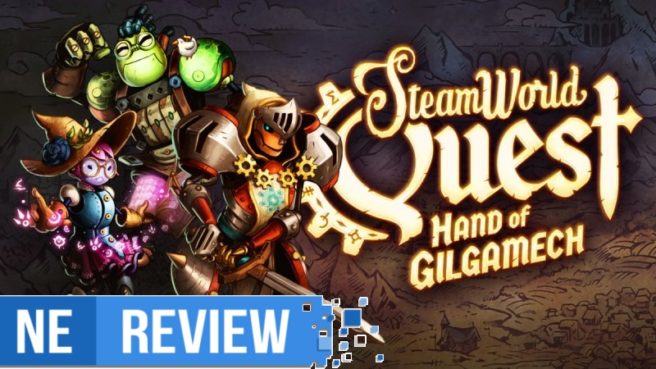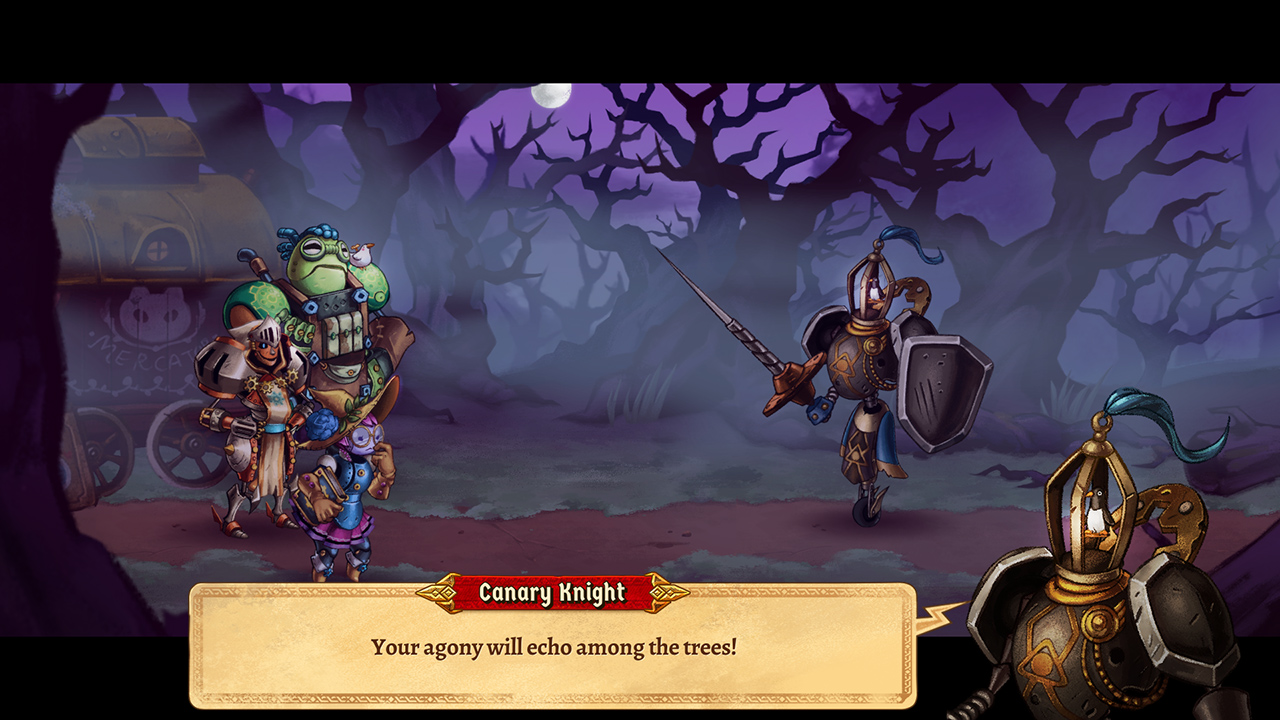[Review] SteamWorld Quest: Hand of Gilgamech
Beyond storyline, the combat system is perhaps the most critical part of any RPG, and just like its narrative, SteamWorld Quest doesn’t exactly push the envelope when it comes to its battles. As a role playing card game, the entire combat system revolves around how you assemble your individual decks. Each member of your party has a deck of eight cards, and cards are randomly drawn from these decks into an active hand of six cards from which three can be drawn in each turn. By using low-energy cards, you can build up steam pressure (SP). SP is required for the most powerful attacks and spells – think of SP as magic points in other RPGs, and you’ll get the gist of how it’s used. Thus, every battle revolves around using low-cost cards to generate SP for a while before cashing them in to charge more effective attacks. There are a few other systems as well – some cards are stronger when played after specific party members’ cards, and if one party member plays three of their cards in a row, they can trigger a chain combo attack. Your deck is constantly changing, with cards that you can pick up in your travels or craft in shops. Aside from that, though, there’s not much more to battles, and they all eventually devolve into the same loop of building up SP, use a big attack, generate some more SP, use it in another big attack – rinse and repeat for about sixteen hours.
There aren’t any random encounters, but battles are nonetheless frequent and lengthy. Most normal encounters feel like they take far longer than they should, since many enemies behave like damage sponges even when exploiting their weaknesses. I don’t have an issue with long battles in general – in fact, they can make an RPG that much more strategic and thrilling. However, when they all effectively boil down to the exact same formula as they do in SteamWorld, that’s a serious problem in my book. This isn’t helped by the fact that most attack animations are excruciatingly slow. Thankfully, there is a fast-forward feature triggered by holding down ZR that speeds up the entire game; better yet, this speed can be set to automatic in the game’s options, so you don’t have to abuse the shoulder button all the time. While I personally think that this fast-forward tempo should have been the default from the beginning, it’s good to have the option to make it so at all.
Perhaps SteamWorld Quest’s biggest issue is its lack of balance. This is especially bizarre considering how linear the game is as a whole. Divided into individual chapters, there is very little room for exploration, going off the beaten path, or skipping ahead. That’s why it’s strange that the game feels so unbalanced in terms of its leveling and gold distribution. Ideally, linear game design should allow the developers to know how much gold you’ll have and what level you’re likely to be at in any context and to scale the game appropriately. However, while playing on normal difficulty, I rarely felt sufficiently leveled or wealthy enough to afford enough new cards and items to comfortably progress with the game, even though I fought every enemy I came across and opened every chest I found. Grinding almost became a necessity – a cardinal sin for any RPG. Fortunately, the game does have several difficulty options, and playing in easy mode does mitigate the need to grind. However, easy mode also increases the looming feeling of monotony that sets in after any slightly extended playtime with the game since it removes most of the game’s challenge. When it comes to the pace, balance, and flow of the general gameplay, SteamWorld Quest shows its full hand all too soon, leading the game to descend into monotony fast.
Even with all these criticisms, there’s still so much to like about SteamWorld Quest. Its visuals are an absolute treat, its character designs are nothing short of exemplary (Copernica is my personal favorite), its writing is snappy, and its gameplay can feel refreshingly simple compared to more complex RPGs. It is in short bursts of playtime that the game truly shines, since the monotony doesn’t have time to rear its ugly head. Playing one chapter at a time, experiencing the basic story, assembling a new deck, taking on a boss, and then setting the game aside for a while is perhaps the ideal way to play it. This method accentuates the game’s strengths: its easy-to-grasp combat, lighthearted attitude, luscious art, and overall charm. Spending any more time with it than that will result in the repetitious faults showing through, however.
The Verdict
SteamWorld Quest is a heartfelt story that’s heavy on charm but light on substance. Beneath its shimmering veneer of painterly vistas and clever writing is a basic core structure that is spread extremely thin over its sixteen-hour main campaign. There is indeed plenty of enjoyment to be had in its witty dialogue, likable characters, straightforward battle system, and beautiful visual presentation. However, with its inherent monotony, unbalanced pacing, and uninteresting main story, there’s just a few too many issues for me to give this fairytale the happy ending of a full recommendation.
SteamWorld Quest review copy provided by Image & Form for the purposes of this review.


